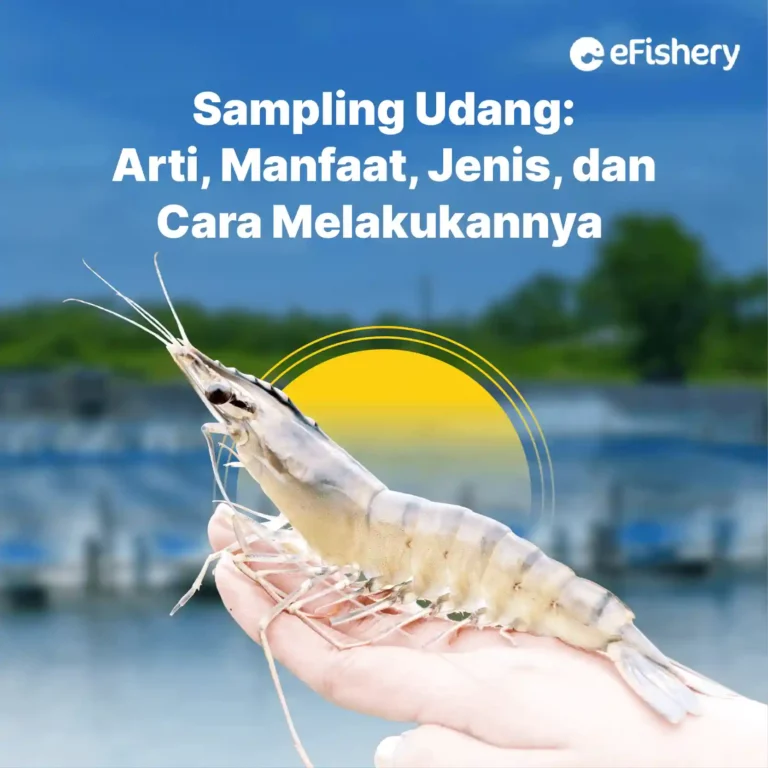Artikel Ini Telah Direview Oleh:

Nabilla Anggi
Magister Budidaya Perairan
When cultivating shrimp, it will be difficult for you to see the overall condition of the shrimp in the pond. To overcome these difficulties, you can do sampling.
Shrimp sampling is one way that you can use to find out the condition of the shrimp in cultivation during the maintenance period. Check it out here for more information on shrimp sampling!
What is Shrimp Sampling?
Sampling or monitoring is the observation of the actual condition of shrimp in certain ponds. Sampling is done to determine the growth or condition of individual shrimp and to calculate shrimp feed requirements.
Shrimp sampling is carried out periodically so that the information or data obtained from shrimp ponds is more precise and actual. Sampling is carried out during the shrimp rearing period by taking samples or samples for inspection.
Kinds of Sampling
Sampling in shrimp farming is divided into 3, namely fry sampling, anco sampling, and net sampling.
- Benur Sampling, done before the fry are spread into the pond. Sampling is done to determine the quality and health of the fry to be stocked.
- Growth Sampling Using Anco, performed the first time on DOC 25-35. Anco is used because the size of the shrimp is still too small, so it is easier to take shrimp samples using anco than nets. In addition to seeing the condition of the shrimp, anco sampling was also carried out to see the shrimp's appetite and determine the amount of feeding at DOC > 30.
- Growth Sampling Using Meshes, done every 7 days in the morning or evening. The purpose of net sampling is to determine shrimp growth and calculate shrimp feed requirements. Sampling of nets was also carried out during partial and total harvests. The goal is that Farmers can determine prices based on sizes and shrimp conditions.
The following is a summary of the three types of shrimp sampling in tabular form:
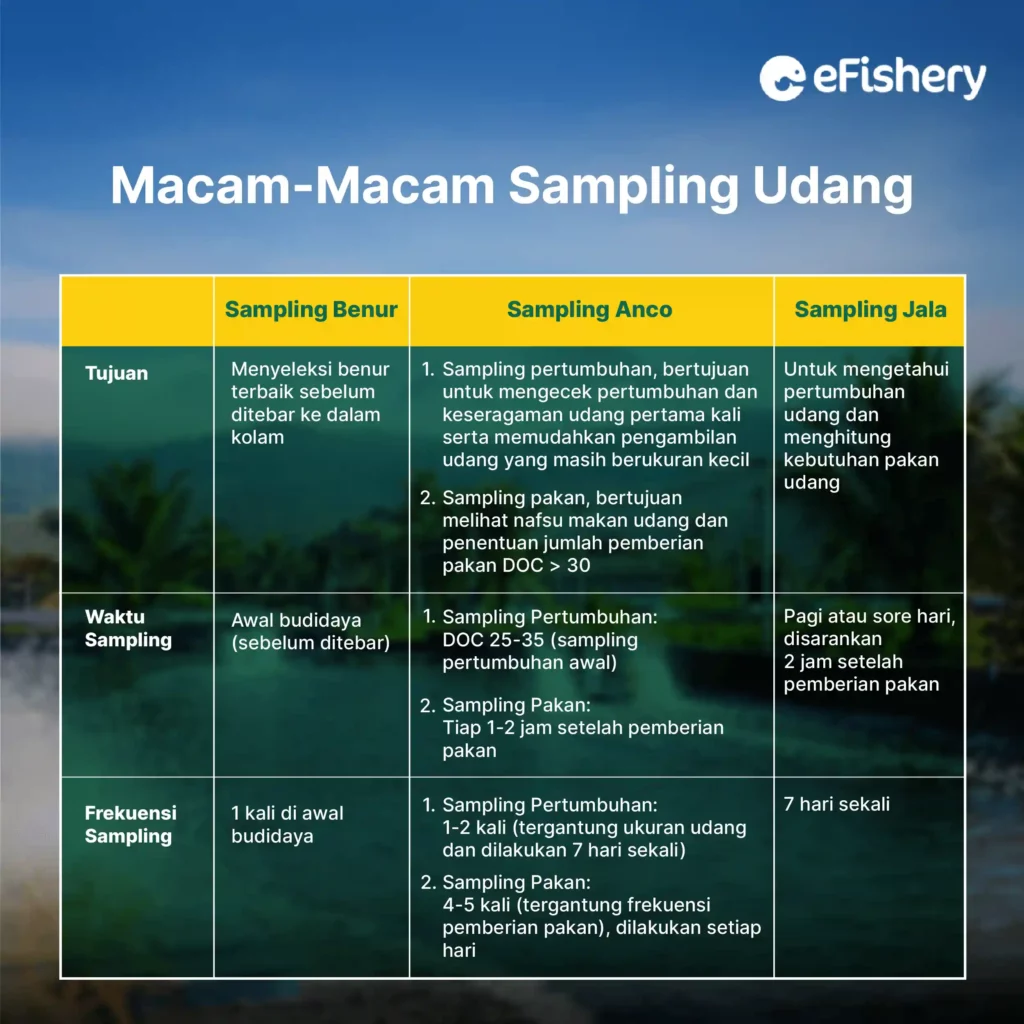
How to Do Sampling
The following is a sampling method that can be done based on the various types:
1. How to Sampling Benur
Sampling fry is a sampling conducted to determine the condition of fry before stocking them into the pond. Sampling of fry was carried out by randomly taking a bag of fry as a sample, then transferring the fry inside into the container that had been prepared. After that, you can check the condition of the fry through visual observation, stress testing, observing the development of gills, and calculating the number of fry.
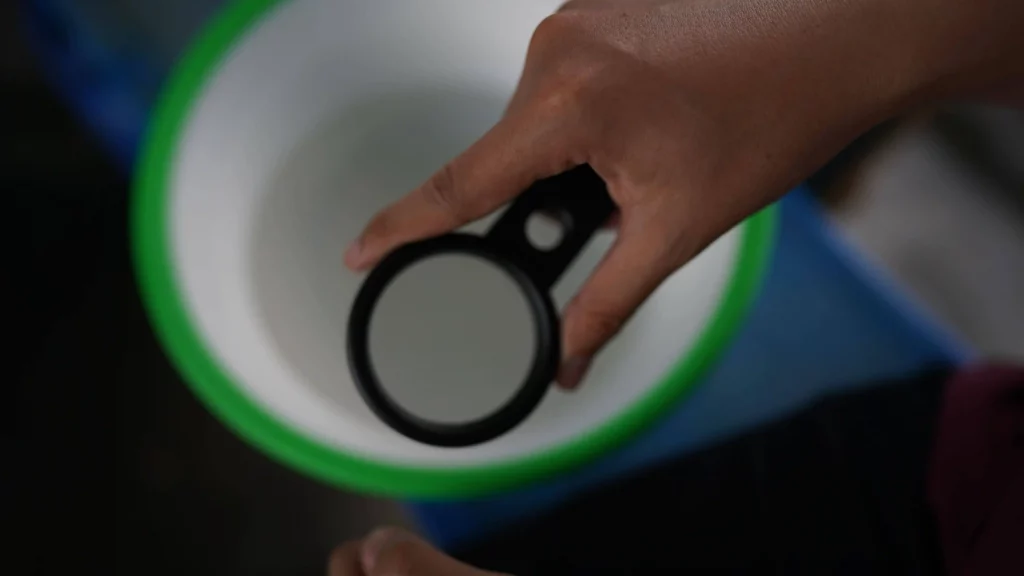
a. Visual Observation
Visual observations are observations that can be seen with the naked eye, such as:
- Limb
Healthy fry have complete limbs, while unhealthy fry usually have limbs that are broken, damaged, or have abnormalities.
- Body Length
Body length adjusted to the selected stadia. PL 10 fry usually have a length of approximately 8 mm.
- Uniformity
One of the characteristics of quality fry is having a uniform size (length and size).
- Activity
Quality fry will actively swim. The way to test the activity of fry is by placing the fry in a basin, then the water is stirred in a circular motion by hand. Good fry will swim against the current and will stick to the wall of the basin. In addition, fry that are touched will immediately give a response such as flicking their body. Conversely, fry that are not good will be carried away by the current and collect in the middle of the basin, and even tend to sink to the bottom of the basin.
- Antenna
Antenna is The first protrusion is at the end of the prawn head which is around the mouth and is usually covered by fine hairs. Good fry antennae are in a closed position.
- Uropods (Fan Tail)
A good fry uropod will expand like a fan.
- Color
The good fry are transparent to brown in color, while the bad ones are reddish in color. The reddish color of the fry shows symptoms of stress which is generally due to the long transportation and processing processes packing which is not good.
- Hepatopancreas
Good fry have a clear hepatopancreas color, are not transparent, and are large in size.
- Intestinal Conditions
Healthy fry have full intestines, while unhealthy fry usually have empty intestines or less than half filled.
- Bacteria Luminescent (Vibrios sp.)
The presence of these bacteria can be detected in a dark room. Bad fry that are infected with the bacteria will look bluish in color.
b. Stress Test
Shrimp fry stress test is divided into 2, namely:
- Salinity Test
This test can be carried out by placing 100 samples of fry and placing them in 1 liter of fresh water of 0 salinity for 30 minutes. Fry that have good quality have survival rate (SR/survival) up to 95%.
- Formalin Test
This test was carried out by placing 100 samples of fry in a container that had been given 200 ppm formalin and 1 liter of sea water. Fry that have good quality have survival rate (SR/survival) up to 95%.
c. Observation of Gill Development
Gill lamellae (gill parts in the form of thin plates, numerous, and close together) on good fry it has formed into branches (filament). The development of gills also follows the stadia or age of the shrimp. The developed fry gills generally have a higher level of life.
d. Calculation of the Number of Benur
The fry samples that have been observed are then counted manually using a tool such as a white scoop so that the fry are clearly visible. To make it easier to count fry, you should use a tool such as a stick cut into small pieces to be used as a marker for the fry count in multiples of a certain number. For example, a multiple of 100 is marked with 1 stick and so on until it's finished. After sampling the fry, the fry are ready to be stocked into the pond.
2. How to Sampling Anco
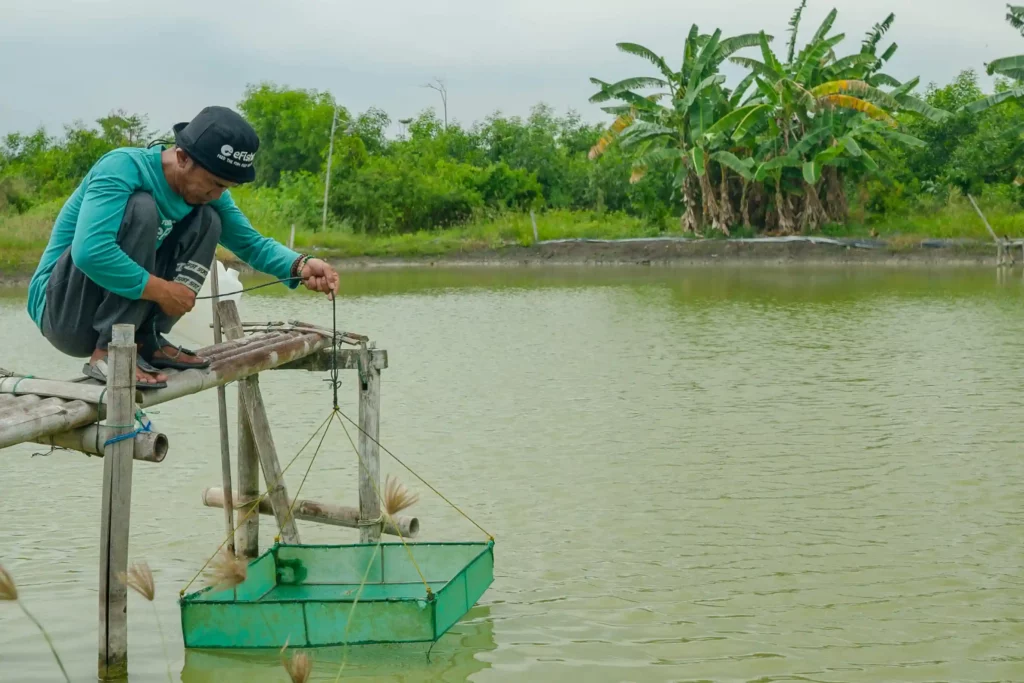
Anco sampling is sampling shrimp growth using anco tools. Anco sampling is usually done during the first sampling at DOC 25-35.
The purpose of using anco during the first sampling is to make it easier to collect shrimp that are still small. In addition, by using anco, the number of shrimp collected is not as much as when using nets.
Anco sampling activities must be carried out quickly to avoid stressed shrimp and decreased shrimp quality. The way of sampling growth with anco is as follows:
- Prepare the tools and materials needed, such as containers filled with water, scales, calculators, rulers, and so on.
- Put the feed into the anco as much as 0.5-1.0% of shrimp body weight per anco, then lower it slowly into the pond and leave it for about 2 hours. You can also do anco sampling 2-3 hours after the morning feeding to shorten the time and maximize the number of shrimp taken.
- Lift the anco slowly using the anco rope.
- Put the shrimp in the anco into the bucket that has been filled with mapped water.
- Put the shrimp into the sampling basket.
- Weigh the shrimp, then record the results.
- Put the shrimp back into the bucket and count the number (tails).
- Put the shrimp back into the pond pond.
- Calculate the average sampling weight (ABW/MBW) and daily weight growth (ADG), then record the results obtained for further decision making, for example calculating the amount of feed.
In addition to knowing ABW/MBW and ADG of shrimp, anco feed sampling can also be used to determine feed requirements at DOC > 30 based on shrimp appetite.
The method is the same as for anco growth sampling, with a few differences. The difference is that anco feed sampling is done every 1-2 hours after feeding. Then, after sampling the feed with the anco, the remaining feed in the anco determines the amount of feed at the next feeding hour.
3. Mesh Sampling Method
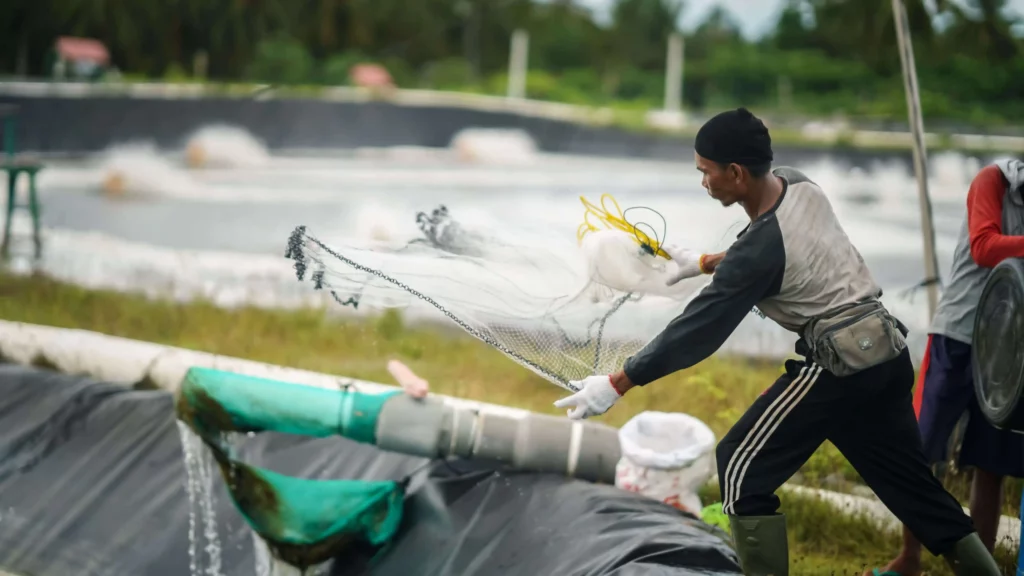
Sampling nets is sampling the growth of shrimp using nets. Sampling nets is usually done when the shrimp are big enough to be netted. The sampling method using nets is as follows:
- Prepare tools and materials such as nets, scales, calculators, containers or baskets, disinfection fluids, and so on.
- Put the nets into the disinfecting fluid to sterilize the nets so that disease-causing pathogens die.
- Throw the mesh around the feed area and pull it up over the surface.
- Place the netted shrimp in a container or basket.
- Weigh the shrimp. Make sure there is no water when weighing, because it will affect the calculation of the weight of the shrimp.
- Count the number of prawns and put them in another basket. Sample shrimp were not put back into the pond.
- Record and calculate the results. The calculated measurement results are the average shrimp weight or Average Body Weight (ABW), sizes (number of shrimp in 1 kg of shrimp weight), growth of shrimp per day or Average Daily Growth (ADG), Survival Rate (SR), feed conversion or Feed Conversion Ratio (FCR), overall shrimp weight (biomass), and determination of feed requirements.
Things to Look For When Sampling
The following things must be considered when sampling:
- Do not use antibiotics, drugs, and prohibited substances in periodic sampling activities for growth, SR, and shrimp biomass. We recommend that you use drugs and saprotam that have been registered with the Directorate General of Aquaculture.
- Make sure the equipment used is sterile. The goal is to avoid transmission of diseases that could be carried on pond equipment.
- Sampling activities should use a normal shrimp count or shrimp that are not molting. It is intended that the calculation results obtained are more accurate.
- Sampling should be carried out in the morning or evening (when conditions are not too hot) so that the harvest of shrimp is maximized and the quality of the shrimp does not decrease.
- Shrimp fasting. You can fast the shrimp if after sampling there are signs of a decrease in appetite, a decrease in the rate of shrimp metabolism, an increase in the remaining feed in the pond, and so on.
Sample Growth Sampling Table
The following is an example of a growth sampling table using anco or nets that can be used as a reference along with how to calculate it:
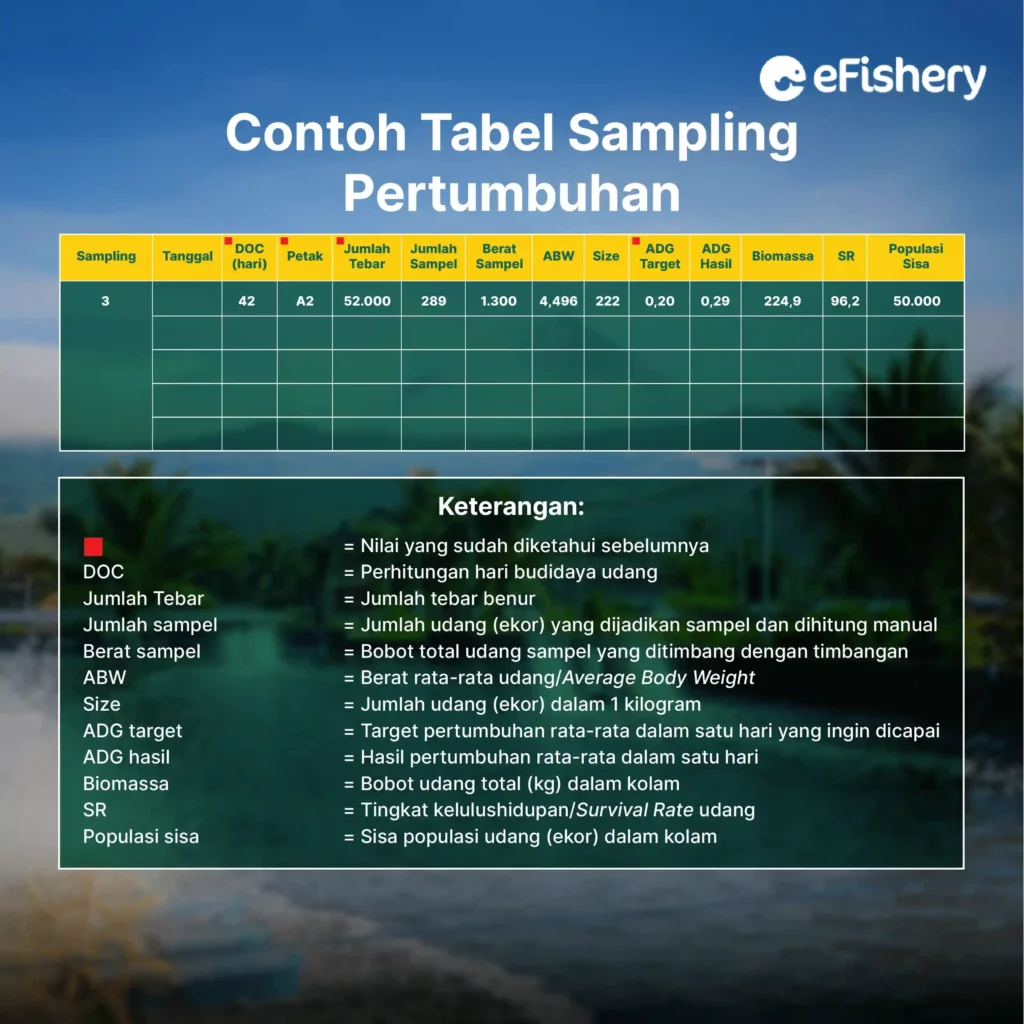
Calculation Example
At the time of Sampling 3 DOC 42 in Block A2, the following information was known:
- Shrimp sample weight = 1,300 gr
- Number of shrimp samples = 289 tails
- Population (total number of shrimp in ponds at sampling 3 DOC 42) = 50,000 heads
- The number of stocking fry = 52,000 head
- Difference in days (difference from sampling 2 to sampling 3) = 7 days
For comparison, it is known that the average ABW of Sampling 2 or DOC 37 is 2.46 grams.
Count:
- ABW (Average Shrimp Weight)
ABW = Weight of Shrimp Samples/Total Shrimp Samples
= 1.300/289
= 4.49 grams
The average weight of shrimp in DOC 42 plots A2 is estimated at 4.49 grams. These results can be compared with the ABW in the previous sampling, whether the shrimp are experiencing good growth or not.
- Size (Number of Shrimp in 1 Kg Weight of Shrimp)
size = 1,000/ABW
= 1.000/4,49
= 222 tails
The size of the DOC 42 shrimp plot A2 is 222, which means that 1 kg of shrimp contains 222 heads. This indicates that the shrimp are not ready to be sold because their size does not meet the market price. Shrimp are usually ready for sale when they enter size 100.
- ADG (Average Growth in One Day)
ADG = (New ABW (DOC 44)-Previous ABW (ABW Sampling 2))/Day difference
= (4.49 – 2.46)/7 days
= 0.29 grams
The average shrimp growth in one day is 0.29 grams. Compared to the desired ADG target of 0.20, the ADG results obtained at the time of sampling have met the target.
- SR (Shrimp Survival Rate)
SR = (Population/Total Stocking of Fry Fry) x 100%
= (50,000/52,000) x 100%
= 96%
SR (shrimp survival rate) 96% is very good because shrimp mortality is only 4%. Usually the SR of shrimp only reaches 80%.
- Biomass (Total Shrimp Weight (kg) in Pond)
Biomass = (Population x ABW)/1,000
= (50,000 x 4.49)/1,000
= 224.5 kg
Biomass is the total or total weight of shrimp in 1 (one) pond where the total weight of shrimp in DOC 44 plot A2 in the pond is 224.5 kg.
Utilize the Cultivation Calculator to Simplify Sampling Parameter Calculations
Need Help Regarding Shrimp Cultivation Business?
Fill in your personal data in the following form. Our team will immediately contact you via the number cellphone attached. Make sure the data entered is correct.
Sampling is one of the mandatory activities carried out during the shrimp rearing period. Through sampling, you can find out the growth of the shrimp and apply good management of the culture.
That's one reason why eFarm equipped with features Cultivation Calculator, to make it easier for you to calculate the components in shrimp growth, such as MBW/ABW, Size, ADG, Population, Biomass, and SR.
eFarm is an application designed to provide solutions for various problems of your shrimp farming. Not only Cultivation Calculator, eFarm also equipped with various other features that make it easier for you to get saprotam, knowledge of shrimp farming, even the right steps for treatment through consultation with shrimp farming experts.
So, downloads eFarm now and enjoy various conveniences in shrimp farming, including fast and accurate sampling calculations Cultivation Calculator!

Nabilla Anggi - Magister Budidaya Perairan
Nabilla merupakan lulusan sarjana dan magister budidaya perairan serta memiliki pengalaman di dunia perikanan baik hatchery maupun pembesaran
Questions Regarding Shrimp Sampling
Sampling or monitoring is observing shrimp to determine the growth or condition of individual shrimp and calculating feed requirements for shrimp.
Anco sampling is sampling shrimp using anco, usually used to determine the condition and appetite of shrimp, while net sampling is sampling shrimp growth using nets.
Sampling in cultivation is divided into 2, namely anco and net sampling. Anco sampling is used to observe shrimp appetite which is carried out according to the frequency of feeding. Anco sampling was also carried out for growth sampling at DOC 30, carried out 1-2 times depending on the size of the shrimp. While net sampling is done every 7 days until the shrimp harvest.
- Adinugroho, M. 2019. Selection and Spread of Fry - Vannamei Shrimp Cultivation. Slideshare. Retrieved April 06, 2023.
- Situbondo Brackish Water Cultivation Fishery Center. 2020. Standard Operating Procedure (SOP) for Growing Vaname Shrimp (Litopenaeus vannamei) in Millennial Ponds. Ministry of Maritime Affairs and Fisheries Directorate General of Aquaculture. 38 p.
- Pratama, A., Wardiyanto and Supono. 2017. Study of the performance of vaname shrimp (Litopenaeus vannamei) reared in a semi-intensive system in pond water conditions with different plankton abundances at the time of stocking. e Journal of Aquaculture Engineering and Technology. VI(1): 643-652
